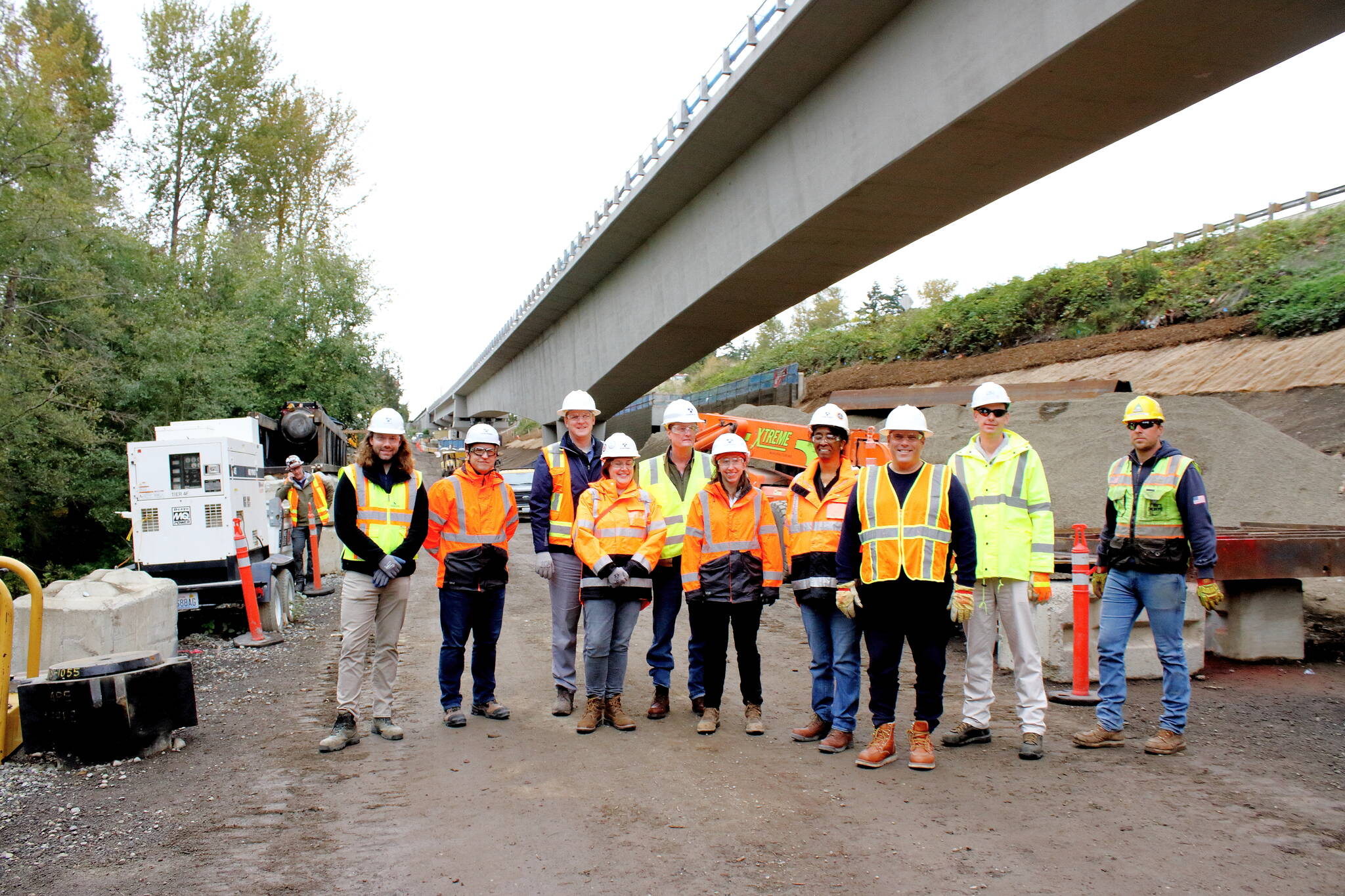Federal Way and Kent residents could see light rail trains traveling along the new tracks by the end of this year as Sound Transit begins its systems integration testing.
The train still won’t be open for public use until 2026 along the 7.8-mile stretch between Federal Way and SeaTac, but a newly completed bridge structure parallel to Interstate-5 near South 259th Place in Kent makes testing possible to begin soon.
The bridge in question is called Structure C, and it points to the completion of an engineering puzzle that took impressive work to solve.
Structure C includes the longest span bridge in the entire light rail system at 500 feet. It stretches over sensitive wetland that also is much too unstable to build on.
Federal Way Mayor Jim Ferrell, Sound Transit staff and a Federal Way Mirror reporter visited the completed bridge on Oct. 18 and saw firsthand the long span that is held up by pillars built over 100 feet deep.
“I could not be more impressed,” Ferrell told the Sound Transit team after the tour.
When it comes to light rail itself, “I think it’s going to really expand the footprint of Federal Way,” Ferrell said. “Federal Way is going to be much more of a destination, especially because this will be the end of the line for a while, but more importantly because it will be a hub in between Seattle and Tacoma. I think Federal Way will really be the center of a convergence location.”
In 1998, Ferrell said he used to ride the bus for an hour and a half every day for work and that while the traffic wasn’t ideal, “I looked forward to that time going back and forth to the courthouse in Seattle. I always had a book with me,” he said. The train will be even more of a relaxing experience, he said, because riders can commute without worrying about traffic.
Earlier options for the light rail route ran along Pacific Highway, which would have avoided the challenge of the wetland. Ferrell said he personally advocated for the route to hug I-5 instead.
“Number one, we have put in $120 million of improvements into Pacific Highway over the course of 18 years, so the last thing we wanted to do was have light rail come in and disrupt and destroy all that infrastructure,” Ferrell said, adding that “we felt it would bisect our town.”
Ferrell said that King County Councilmember Pete von Reichbauer’s help was instrumental in supporting the changed route.
“Sound Transit learned so many lessons over the past 20 years, making sure they’re working with communities and are being very transparent and, you know, really dedicated to getting it right,” Ferrell said.
Sound Transit has also focused on equity in its hiring and contracting. Within the workforce building, the Federal Way Link, 17.2% is comprised of those in an apprenticeship, 36.2% are people of color and 7.7% are women, according to the agency.
Ferrell also expressed gratitude for the way Sound Transit has worked with the city of Federal Way and emphasized that delays due to changed plans are a welcome part of the process if they’re needed.
“This is hundred-year infrastructure. We want it done right,” Ferrell said.
At one point in the building process, the builders ran into a challenging issue that required the use of divers to remedy. Workers from Sound Transit summarized the scenario as follows.
In one of the shafts, the rebar cage that is meant to slide up the poured concrete pillar as it is poured got stuck. The hole that the pillar was meant to be poured into was full of water because the water table in that area is so high, so to extract the stuck rebar cage, they had to send divers down into the water, according to Sound Transit.
The divers from Ballard Marine had to work on the cage by touch because the mix of water, lubricant and soil they were diving in was so thick that visibility was zero. At the bottom of a 100-foot-deep soupy hole, they used torches and drills to work on the freeing and then rebuilding a rebar cage, according to Sound Transit.
While this was the most complicated challenge they had to face while working on this part of the light rail track, it represents just one of many engineering feats and creative solutions that Sound Transit has taken to create the bridge.
According to the agency, while the massive light rail infrastructure might seem static and immovable, something as simple as temperature could cause the bridge to rip itself apart if engineering precautions were not taken. The steel rails that the trains run on actually contract and expand as much as 11 inches depending on the temperature. To keep this from impacting the bridge, a sliding rail expansion joint allows the rails to flex.
Now that the rail and the bridge are essentially complete, crews will start working on the light rail systems, including aspects like the poles and the wires that power the train.
The $2.4 billion project will have three light rail stations, two in Kent and one in Federal Way.
Talk to us
Please share your story tips by emailing editor@kentreporter.com.
To share your opinion for publication, submit a letter through our website https://www.kentreporter.com/submit-letter/. Include your name, address and daytime phone number. (We’ll only publish your name and hometown.) Please keep letters to 300 words or less.

